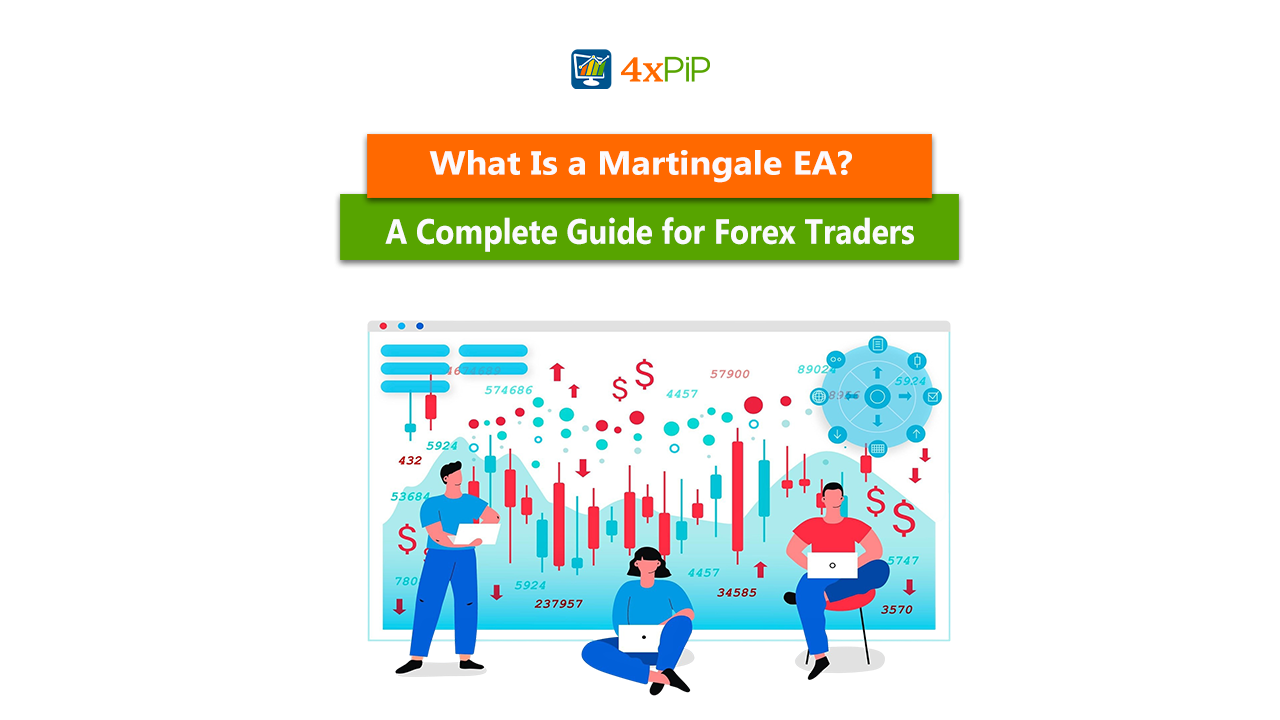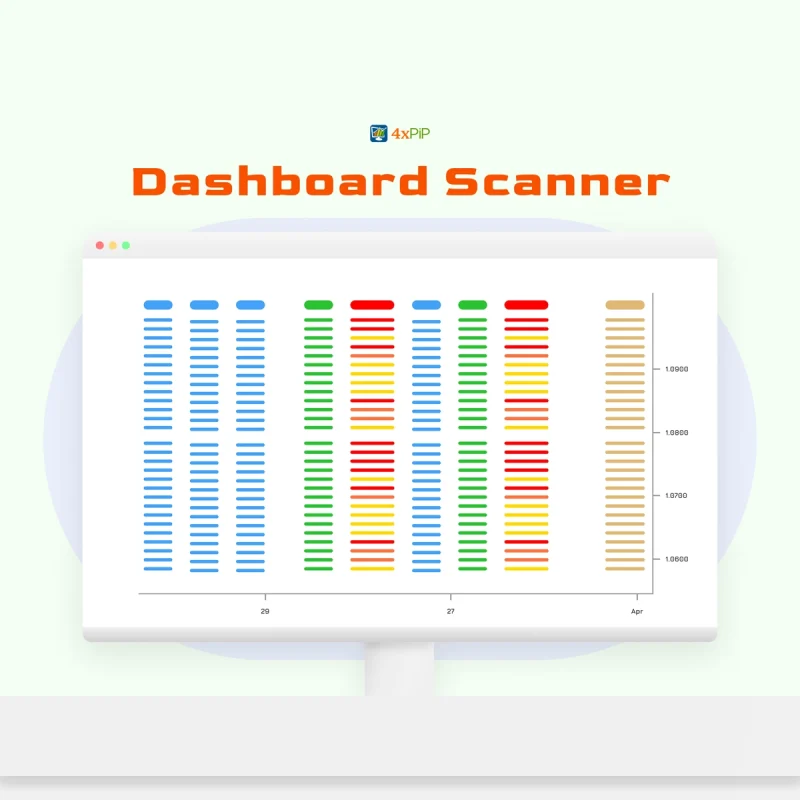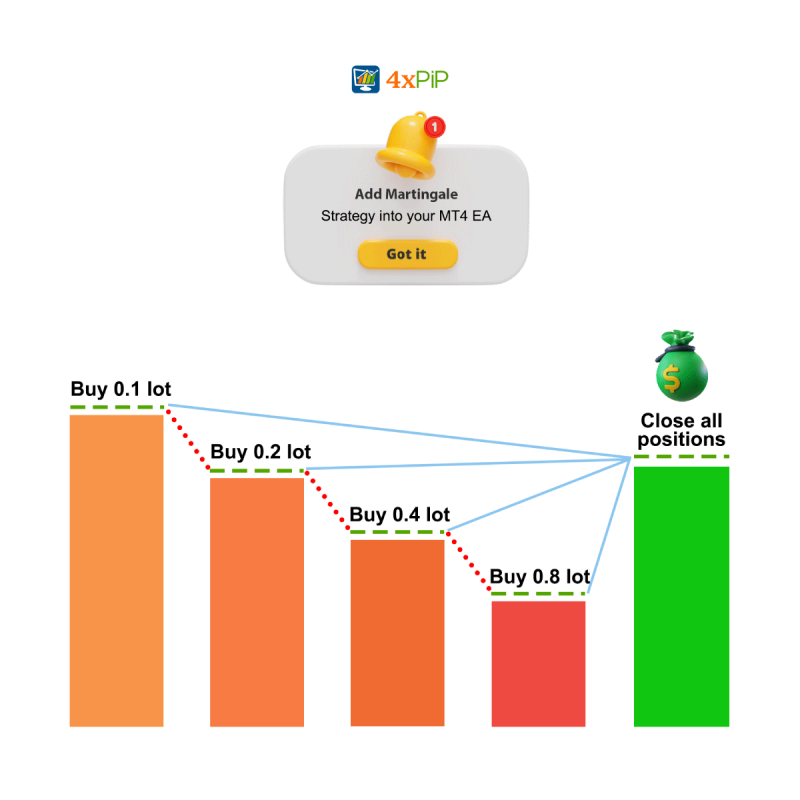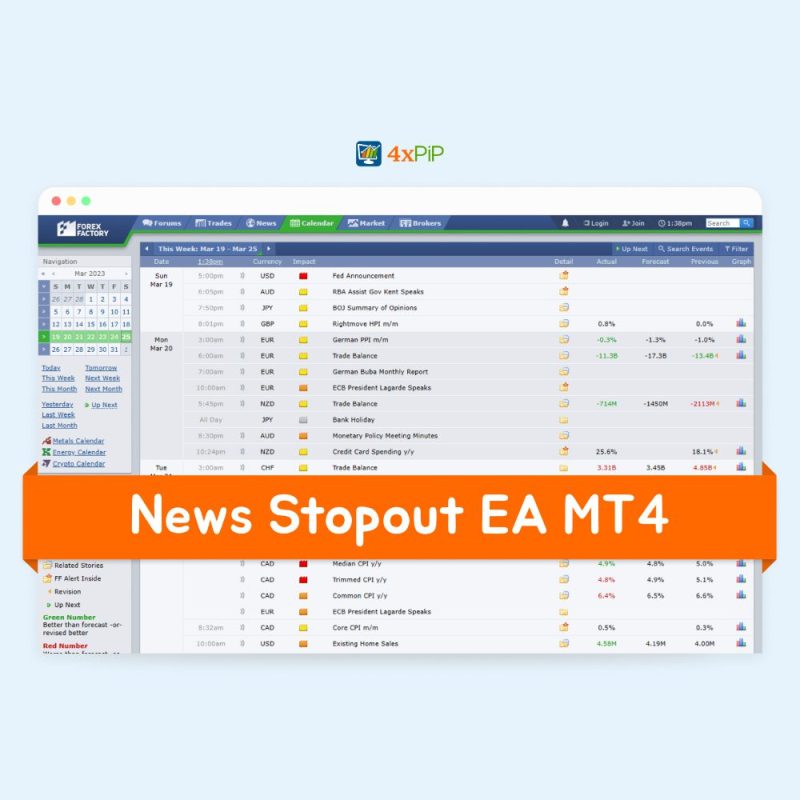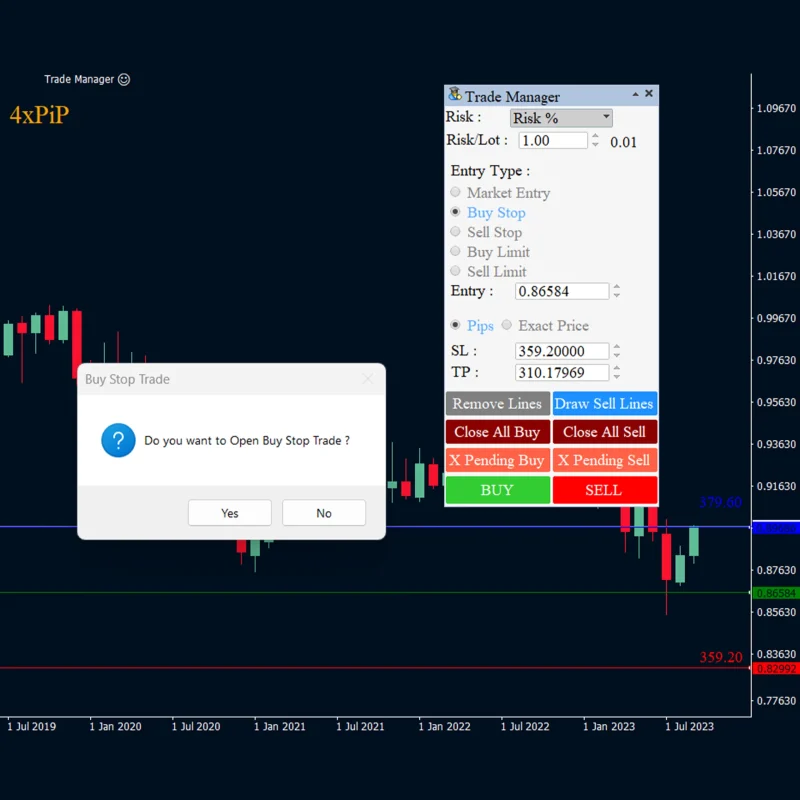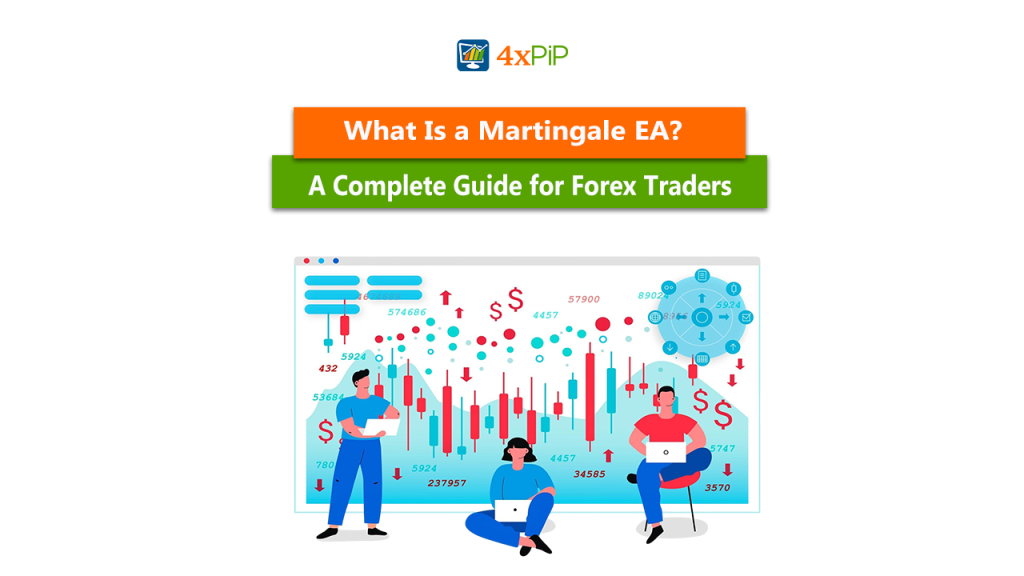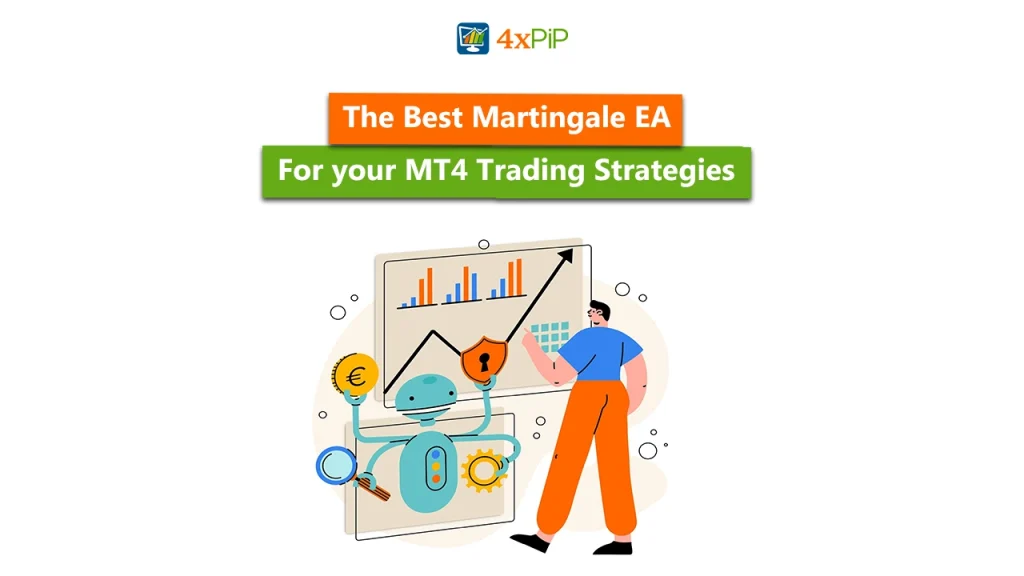A Martingale EA is an automated trading bot that applies the Martingale strategy within MetaTrader to recover losing trades by increasing position size after each loss. In simple terms, if a trade moves against you, the EA doubles or multiplies the next order’s lot size so that when the market eventually reverses, all positions close together in profit. This approach reduces drawdown and aims to turn losing trades into winning ones, making it a popular yet high-risk method among Forex traders.
Before using such a system, it’s important to understand both sides of the equation. The Martingale method can deliver strong results during ranging markets, but it also carries significant risk in trending conditions, where continuous doubling can quickly exhaust account equity. Traders usually manage this risk by setting parameters like maximum orders, lot multipliers, step size (distance between trades), and a stop-out percentage. Some also prefer using cent accounts or smaller lot sizes to reduce exposure. For those who want a ready-to-use solution, 4xPip provides an optimized Martingale EA with customizable settings for safer application.
Martingale Strategy in Forex

The Martingale strategy originated as a betting system where a player doubles the wager after every loss, with the expectation that a single win would recover all previous losses plus deliver a small profit. In Forex trading, the same logic is applied: after a losing trade, the position size is increased (often doubled) so that when the market eventually reverses, the series of trades closes at a net profit. This method can look highly attractive in volatile markets, as price swings often provide enough movement for recovery. However, the same volatility also makes it dangerous. Extended trends against the position can drain account equity quickly if the lot size grows uncontrollably.
To start exploring this approach safely, traders often rely on 4xPip’s Martingale EA, which allows full customization of martingale parameters. Setting it up is straightforward: install the bot into MetaTrader, attach it to a chart, and adjust the key inputs such as lot size, multiplier, maximum orders, and step distance (grid spacing). The EA will then manage the sequence of trades automatically, applying a centralized take profit to close the entire batch in profit. For users, this means testing the Martingale phenomenon under controlled settings like fine-tuning the risk, defining a stop-out percentage, and using recovery features without manually calculating each step.
What Is a Martingale EA and How Does It Work?
A Martingale Expert Advisor (EA) is a trading bot that applies the Martingale strategy in MetaTrader. Instead of manually increasing lot sizes after losses, the EA automates the process by following a fixed set of rules. It opens an initial order, then if the market moves against that position, it places the next trade with a higher lot size based on a multiplier or increment. Each new trade is spaced by a predefined number of pips, known as the “step distance.” When price retraces, the EA uses a centralized take profit to close all trades in the sequence together at a net profit. This makes execution consistent and emotion-free, but the risks remain the same, continuous adverse moves can still cause equity depletion.
To make this approach practical, the Martingale EA from 4xPip lets traders define lot multipliers, maximum orders, and stop-out percentages before running the strategy. For example, you could set a multiplier of 2, a max of 5 trades, and a step size of 20 pips. In that case, the EA will automatically manage the sequence, adjusting take profit, displaying active trades, and applying recovery mechanisms through counter trades. This ensures traders can test Martingale safely under controlled parameters, instead of manually calculating each entry.
Key Features of a Martingale EA
Instead of relying on manual adjustments, the Martingale EA handles all the repetitive calculations, trade placements, and position management in real time. While the exact configuration may vary from one EA to another, most Martingale systems share a core set of the following features:
- Lot Size Progression: The Martingale approach relies on scaling lot sizes after each losing trade. For example, a 0.1 lot position can grow into 0.2, 0.4, and 0.8 lots if the market keeps moving against the initial entry. This scaling creates the potential to recover earlier losses when the market reverses.
- Grid Order Placement: Instead of placing random trades, a Martingale EA follows a well-made grid system. New trades open after the price moves a certain number of pips (steps) against the previous trade, ensuring even spacing and consistent coverage of the market.
- Centralized Take-Profit: All trades in the basket are managed by a single take-profit level. Once the combined floating loss and profit align, the EA closes the entire group together in profit. This avoids situations where some trades are closed too early while others remain in heavy drawdown.
- Adjustable Parameters: Users can customize settings such as lot multiplier, step distance, maximum number of Martingale orders, and stop-out percentage. These inputs give traders control over risk tolerance, profit targets, and overall exposure.
- Drawdown Control: By setting a maximum drawdown limit or stop-out percentage, traders can create a safety net to prevent the EA from overextending during extreme volatility.
The Martingale EA from 4xPip combines all of the above in a ready-to-use format. Instead of manually calculating multipliers, grid steps, or centralized take profit, users can install it on MetaTrader and immediately start adjusting settings to fit personal risk levels.
Risks and Drawbacks of Using a Martingale EA
While Martingale EAs can accelerate profit recovery, they expose traders to some of the highest risks in automated trading. The core issue is the compounding nature of lot sizes as every losing position is followed by a larger one. In a trending market that fails to reverse, this creates a chain of oversized positions that can drain margin quickly. Traders must also consider that market volatility is unpredictable; relying on price retracements that may never arrive puts the account at constant risk.
Key risks include:
- High Drawdown Potential: Martingale compounding can push drawdown beyond manageable levels during extended losing streaks.
- Margin Calls & Wipeouts: Continuous lot escalation consumes equity rapidly, leaving accounts exposed to forced liquidation.
- Dependency on Retracements: The strategy assumes reversals will occur, but strong trends can continue longer than expected.
- Overexposure in Volatile Markets: Grid-style placements may stack too many trades in unpredictable conditions.
To work within safer limits, 4xPip’s Martingale EA provides controls like maximum orders, adjustable lot multipliers, and stop-out percentages, allowing traders to test risk tolerance in a demo before scaling to live accounts.
Practical Applications and When Traders Use Martingale EAs
Martingale EAs are usually applied in specific situations where traders aim to recover small losses quickly. The strategy tends to work best in ranging markets, where price frequently retraces, allowing the system to close a series of trades in profit. Some traders also use it with smaller accounts to attempt rapid equity growth, though this comes with higher risk. In controlled conditions, such as demo testing or short-term experiments, Martingale can provide insights into market behavior and risk tolerance.
Common applications include:
- Ranging or Sideways Markets: Ideal when prices oscillate within defined levels.
- Small Accounts: Some traders attempt fast growth, though with limited capital, risk rises.
- Short-Term Profit Goals: Effective if reversals happen quickly.
- Demo Testing Environments: Allows users to test strategies without risking real funds.
- Controlled Market Conditions: More suitable when volatility is low and trends are limited.
For traders interested in trying this method, the 4xPip Martingale EA offers a practical way to start. It comes with adjustable parameters such as lot multipliers, maximum orders, and centralized take profit levels, giving us control over how aggressively or conservatively the bot manages trades. By installing it on MetaTrader and first running it in a demo account, we can safely explore how the Martingale strategy reacts before moving into live trading.
Safer Alternatives and Risk Management Considerations
Compared to Martingale, alternative approaches such as fixed lot trading or hedging carry far less exposure. Fixed lot trading ensures position sizes remain constant, making drawdown predictable and easier to manage. Hedging strategies, on the other hand, open offsetting trades to reduce risk when the market moves against us, giving more flexibility in volatile conditions. These methods emphasize preservation of capital, whereas Martingale aggressively compounds risk.
Regardless of the method, effective risk management is essential. We need to define strict rules for capital allocation, set stop-loss thresholds, and limit maximum exposure per trade cycle. Martingale should only be used with full awareness of its risks and with safeguards in place. In retrospect, the 4xPip Martingale EA supports this by letting us adjust inputs such as lot multiplier, maximum Martingale orders, centralized take profit, and stop-out percentage directly in MetaTrader. By first installing it on a demo chart, tweaking these risk parameters, and observing performance, we can explore the Martingale method while keeping risk under tighter control.
Summary
A Martingale EA is a type of automated trading bot designed to recover losses by increasing lot sizes after each losing trade. This approach can turn a losing streak into a net profit once the market retraces, but it carries significant risks if a strong trend continues without reversal. Traders who build or use their own Martingale EA in MetaTrader can adjust parameters such as lot multipliers, step distance, maximum orders, and stop-out percentages to manage exposure. While Martingale can perform well in ranging markets, it also has the potential to cause severe drawdowns in trending conditions. For those exploring this method, tools like the 4xPip Martingale EA provide customizable features, demo testing options, and integrated risk controls to help traders apply the strategy more safely.
4xPip Email Address: [email protected]
4xPip Telegram: https://t.me/pip_4x
4xPip Whatsapp: https://api.whatsapp.com/send/?phone=18382131588
FAQs
- What is a Martingale EA in Forex trading?
It’s an automated bot that increases trade size after each loss, aiming to recover previous losses when the market eventually reverses. - How does a Martingale EA work in MetaTrader?
The EA opens an initial trade, then increases lot size for subsequent trades after losses. All trades close together in profit once price retraces to a set take-profit level. - Why do traders use Martingale EAs?
They use them to recover small losses quickly in ranging markets where price frequently moves back and forth. - What are the key settings in a Martingale EA?
Common inputs include lot multiplier, maximum number of orders, step size (grid distance), and stop-out percentage. - What are the main risks of Martingale trading?
Risks include large drawdowns, margin calls, dependency on market retracements, and potential account wipeouts during strong trends. - Can Martingale EAs work in all market conditions?
No. They are best suited for ranging or sideways markets. In trending conditions, the compounding effect often increases risk dramatically. - How can traders reduce the risks of Martingale?
By limiting maximum orders, lowering lot multipliers, using cent accounts, or setting strict stop-out percentages to cap drawdown. - What are safer alternatives to Martingale?
Fixed lot trading and hedging are common alternatives that offer steadier exposure and greater capital protection. - Should traders test a Martingale EA before going live?
Yes. Demo testing is essential to fine-tune settings and evaluate performance before applying the bot to a live account. - How does the 4xPip Martingale EA help traders?
It provides customizable settings, integrated risk controls, and easy installation, allowing traders to experiment with Martingale under safer, controlled conditions.

